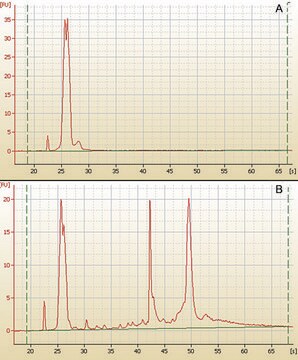SCT064
BioTracker NTP-Transporter Molecule
Quick and efficient transport of labeled NTPs into cells for live cell imaging of DNA replication, synthesis, etc. Labeling of DNA with fluorescent NTPs is one of the essential methods in cell cycle analysis.
Synonim(y):
Sonda do obrazowania żywych komórek, Wykrywanie cyklu komórkowego
About This Item
Polecane produkty
Próba
≥98% (H-NMR)
≥98% (HPLC)
≥98% (LC/MS)
≥98% (elemental analysis)
metody
cell based assay: suitable
metoda wykrywania
fluorometric
Opis ogólny
BioTracker<TMSYMBOL></TMSYMBOL> NTP-Transporter Molecule has a receptor site, for selectively binding to the NTPs, and a cell penetrating agent. The transporter can bind to NTPs and quickly move them into cells without any apparent damage to the cell membrane or decrease in cell viability. The transported NTP is rapidly liberated from the complex and available in the nuclei for incorporation into DNA. Labeled NTPs can be used for live cell imaging, cell proliferation assays, synthetic biology studies, synthesizing artificial DNA, tracking cell division, research on active antiviral and anticancer nucleotides, among other things.
Zastosowanie
Cell Imaging
Cell Cycle, DNA Replication & Repair
DNA Damage & Repair
Jakość
Molar Mass: 3470.14 g/mol
Postać fizyczna
Przechowywanie i stabilność
Note: Centrifuge vial briefly to collect contents at bottom of vial before opening.
Inne uwagi
Oświadczenie o zrzeczeniu się odpowiedzialności
Kod klasy składowania
11 - Combustible Solids
Klasa zagrożenia wodnego (WGK)
WGK 3
Temperatura zapłonu (°F)
Not applicable
Temperatura zapłonu (°C)
Not applicable
Certyfikaty analizy (CoA)
Poszukaj Certyfikaty analizy (CoA), wpisując numer partii/serii produktów. Numery serii i partii można znaleźć na etykiecie produktu po słowach „seria” lub „partia”.
Masz już ten produkt?
Dokumenty związane z niedawno zakupionymi produktami zostały zamieszczone w Bibliotece dokumentów.
Produkty
Regulation of the cell cycle involves processes crucial to the survival of a cell, including the detection and repair of genetic damage as well as the prevention of uncontrolled cell division associated with cancer. The cell cycle is a four-stage process in which the cell 1) increases in size (G1-stage), 2) copies its DNA (synthesis, S-stage), 3) prepares to divide (G2-stage), and 4) divides (mitosis, M-stage). Due to their anionic nature, nucleoside triphosphates (NTPs), the building blocks of both RNA and DNA, do not permeate cell membranes.
Nasz zespół naukowców ma doświadczenie we wszystkich obszarach badań, w tym w naukach przyrodniczych, materiałoznawstwie, syntezie chemicznej, chromatografii, analityce i wielu innych dziedzinach.
Skontaktuj się z zespołem ds. pomocy technicznej



![Water, PCR Grade liquid, pkg of 25 mL (03315959001 [1 x 25 ml]), pkg of 25 mL (03315932001 [25 x 1 ml]), pkg of 100 mL (03315843001 [4 x 25 ml])](/deepweb/assets/sigmaaldrich/product/images/326/208/bac83eed-3c88-4738-b4b5-50d3b223dd1c/640/bac83eed-3c88-4738-b4b5-50d3b223dd1c.jpg)


